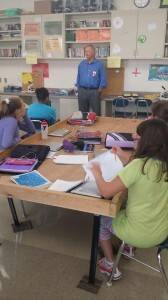
Late last week I was contacted by our Ag in the Classroom staff from North Iowa Ag in the Classroom about a book being used in the Mason City sixth grade as a textbook. This nonfiction book by Micheal Pollan, entitled Omnivore’s Dilemma, is being used for every class – even art!
At first blush, it sounds like this book would be about all the food choices available in America. But that’s not the case! Omnivore’s Dilemma is filled with half-truths and misinformation. For example, Pollan implies that government subsidies force farmers to grow corn and Americans are becoming obese because corn is “hidden” in so many food products.
Pollen’s book also states that people are half made up of corn. Now this simply isn’t true! Using basic math, one can deduce this isn’t possible since the average human body is composed 60 percent of water. And that’s a fact! (Let fact, no fear, determine food acceptance. I support agriculture that improves the quality and quantity of food available.)
Thanks to Pollan’s nonfiction writing and the concern this “textbook” has caused among farmers and those who work with North Iowa’s Ag in the Classroom program, I found myself facing a dilemma… Should I combine my soybeans or head into the classroom?
Because I whole-heartedly believe we must connect farming and food to the classroomx, yesterday I found myself getting behind the wheel of my pickup rather than my combine. It honestly felt privileged to talk with six classes of sixth graders yesterday. My main message was to remind these middle school students, who are like a sponge absorbing information, to keep an open mind when reading information. I reminded them to consider the source of information and to not take all printed material as fact.
I also encouraged them to ask farmers question about why they do what they do. As you might expect, I got a lot of questions from them! These kids asked really thoughtful and engaging questions.
One young person asked, “If you think you’re going to lose money, why do you go ahead and plant your crops?”
“How do farmers get such big equipment?”
What kind of education does it take to become a farmer?
These kids had so many good questions! Another girl asked if I name my pigs. That opened up a conversation about the difference between pets and food production. We talk about the cycle of life and how some animal’s purpose in life is to become food. That’s natural. It happens in nature, too.
Conversations like this with non-farmers help us find common ground. I consider telling my farm’s story and educating consumers – even future consumers – to be a very important part of my operation. That’s why today I’ll be getting my pickup truck again, driving about 45 minutes north, and spending another full day talking to more students.
We all must keep sharing our farm story. It’s quite apparent other sources of information are getting into our schools, and that information might not be accurate!
